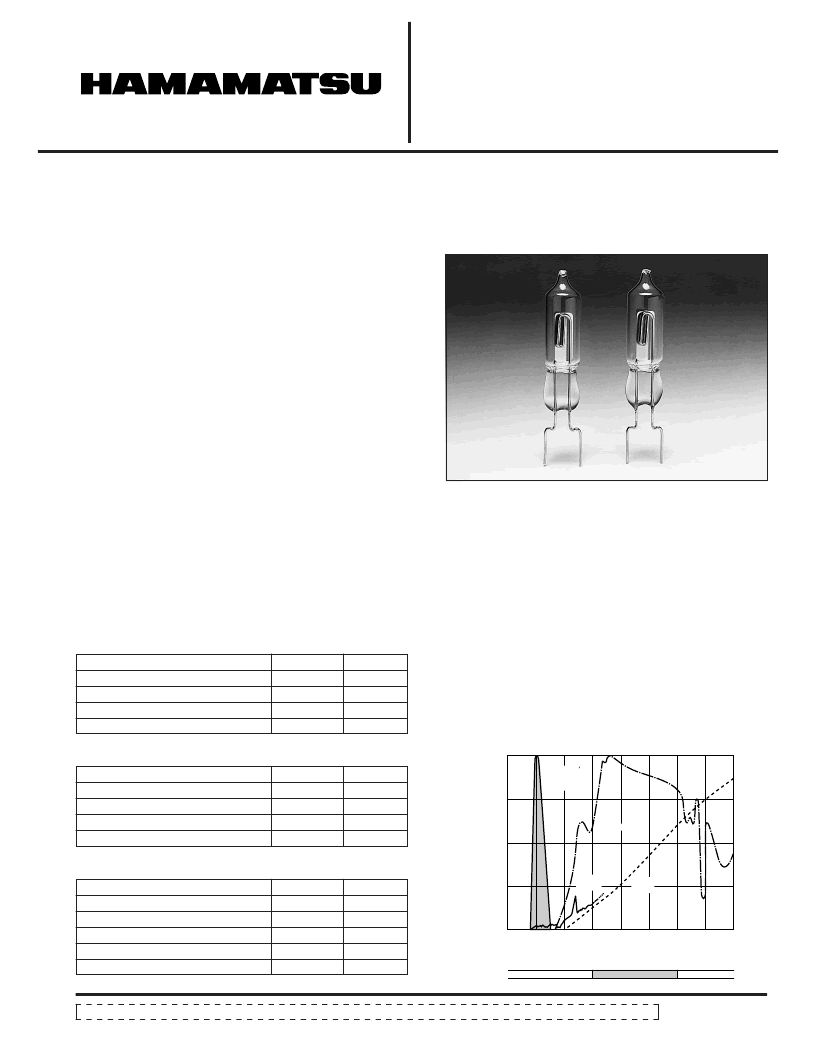- 您現(xiàn)在的位置:買賣IC網(wǎng) > PDF目錄376299 > R2868 (Hamamatsu Photonics) FLAME SENSOR UV TRON PDF資料下載
參數(shù)資料
| 型號(hào): | R2868 |
| 廠商: | Hamamatsu Photonics |
| 英文描述: | FLAME SENSOR UV TRON |
| 中文描述: | TRON的紫外火焰?zhèn)鞲衅?/td> |
| 文件頁數(shù): | 1/2頁 |
| 文件大小: | 143K |
| 代理商: | R2868 |

FLAME SENSOR
UV TRON
R2868
Subject to local technical requirements and regulations, availability of products included in this promotional material may vary. Please consult with our sales office.
Information furnished by HAMAMATSU is believed to be reliable. However, no responsibility is assumed for possible inaccuracies or omissions.
Specifications are subjected to change without notice. No patent rights are granted to any of the circuits described herein. 1997 Hamamatsu Photonics K. K.
Quick Detection of Flame from Distance,
Compact UV Sensor with High Sensitivity and Wide Directivity,
Suitable for Flame Detectors and Fire Alarms.
Hamamatsu R2868 is a UV TRON ultraviolet detector that makes
use of the photoelectric effect of metal and the gas multiplication
effect. It has a narrow spectral sensitivity of 185 to 260 nm, being
completely insensitive to visible light. Unlike semiconductor
detectors, it does not require optical visible-cut filters, thus
making it easy to use.
In spite of its small size, the R2868 has wide angular sensitivity
(directivity) and can reliably and quickly detect weak ultraviolet
radiations emitted from flame due to use of the metal plate
cathode (eg. it can detect the flame of a cigarette lighter at a
distance of more than 5 m.).
The R2868 is well suited for use in flame detectors and fire
alarms, and also in detection of invisible discharge phenomena
such as corona discharge of high-voltage transmission lines.
APPLICATIONS
G
Flame detectors for gas/oil lighters and matches
G
Fire alarms
G
Combustion monitors for burners
G
Inspection of ultraviolet leakage
G
Detection of discharge
G
Ultraviolet switching
GENERAL
Parameters
Rating
Units
Spectral Response
185 to 260
nm
Window Material
UV glass
—
Weight
Approx. 1.5
g
Dimensional Outline
See Fig. 3
—
MAXIMUM RATINGS
Parameters
Rating
Units
Supply Voltage
400
Vdc
Peak Current
1)
30
mA
Average Discharge Current
2)
1
mA
°
C
Operating Temperature
-20 to +60
CHARACTERISTICS (at 25
°
C)
Parameters
Rating
Units
Discharge Starting Voltage (with UV radiation)
280
325
±
25
100
Vdc Max.
Recommended Operating Voltage
Vdc
μ
A
Recommended Average Discharge Current
Background
3)
10
cpm Max
Sensitivity
4)
5000
cpm Typ.
NOTES:
1) This is the maximum momentary current that can be handled if its full width
at half maximum is less than 10
μ
s.
2) If the tube is operated near this or higher, the service life is noticeably reduced.
Use the tube within the recommended current values.
3) Measured under room illuminations (approximately 500 lux) and recommended
operating conditions. Note that these values may increase if the following
environmental factors are present.
1. Mercury lamps, sterilization lamps, or halogen lamps are located nearby.
2. Direct or reflected sunlight is incident on the tube.
3. Electrical sparks such as welding sparks are present.
4. Radiation sources are present.
5. High electric field (including static field) generates across the tube.
4) These are representative values for a wavelength of 200 nm and a light input
of 10 pW/cm
2
. In actual use, the sensitivity will vary with the wavelength of the
ultraviolet radiation and the drive circuitry employed.
Figure 1: UV TRON’s Spectral Response and Various
Light Sources
TPT B0009EA
200
300
400
500
600
700
800
900
100
WAVELENGTH (nm)
R
100
50
0
UV TRON s
SPECTRAL
RESPONSE
SUNLIGHT
GAS
FLAME
TUNGSTEN
LIGHT
ULTRAVIOLET
VISIBLE
INFRARED
相關(guān)PDF資料 |
PDF描述 |
|---|---|
| R329-02 | PHOTOMULTIPLIER TUBE |
| R3292 | POSITION-SENSITIVE PHOTOMULTIPLIER TUBES |
| R3310-02 | PHOTOMULTlPLlER TUBES |
| R331 | PHOTOMULTIPLIER TUBES |
| R331-05 | PHOTOMULTIPLIER TUBES |
相關(guān)代理商/技術(shù)參數(shù) |
參數(shù)描述 |
|---|---|
| R2868_TPT1008E02 | 制造商:HAMAMATSU 制造商全稱:Hamamatsu Corporation 功能描述:Quick Detection of Flame from Distance, |
| R287131002 | 制造商:Radiall 功能描述:ASS'Y SMA M - M CAB RG 142 - Bulk |
| R287131003 | 制造商:Radiall 功能描述:ASS'Y SMA M - M CAB RG 142 - Bulk |
| R287131004 | 制造商:Radiall 功能描述:ASS'Y SMA M - M CAB RG 142 - Bulk |
| R287131005 | 制造商:Radiall 功能描述:ASS'Y SMA M - M CAB RG 142 - Bulk |
發(fā)布緊急采購,3分鐘左右您將得到回復(fù)。